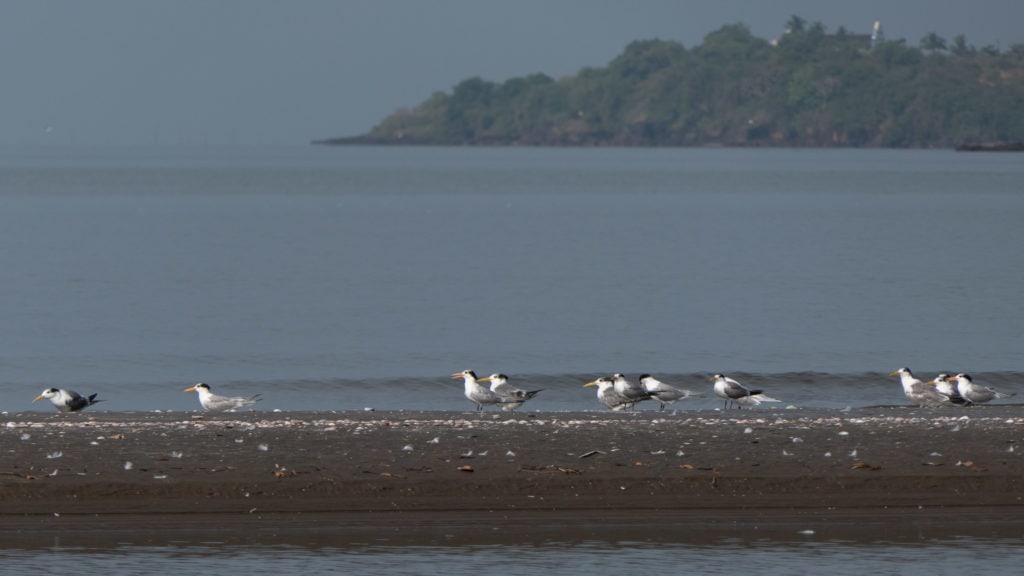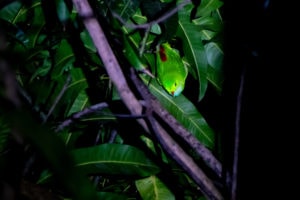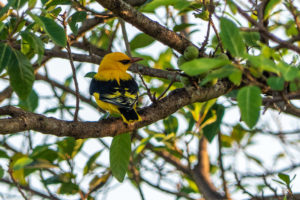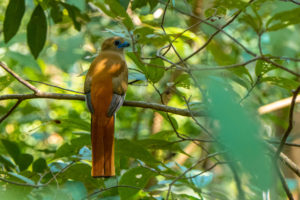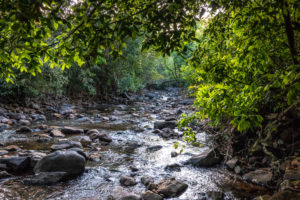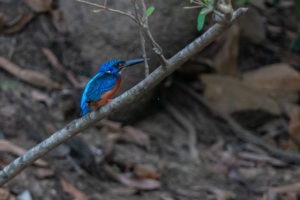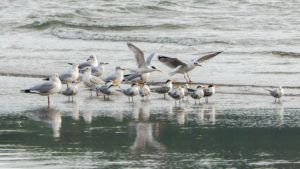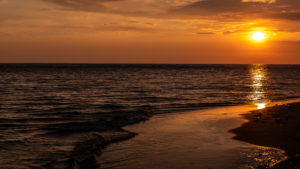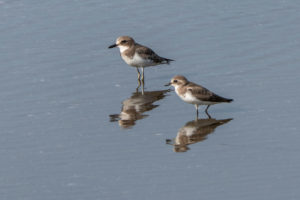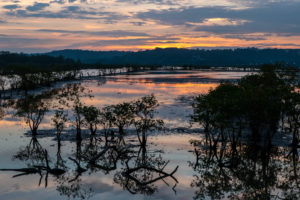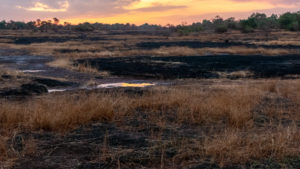Contents
Summary
The fourth trip in our series of short “Looking up from lockdown“ tours to top Indian birding destinations, taking advantage of a relaxation in COVID-19 restrictions, was to the popular coastal state of Goa.
Itineraries were designed to be easy-paced, minimising travel, and using established bases that we knew to be implementing sensible health precautions. Overall birding was as usual fantastic, and we definitely felt safer being in outside environments in remote and uncrowded places, than stuck at home in towns and cities hardly getting out!
Goa has fantastic variety for birding. As well as the coastal wetlands, Western Ghats forests and inland marshes, the rocky laterite plateau provides a habitat for open-country and dry land birds. With beautiful scenery, friendly people, relaxing beaches, delicious seafood, and a great selection of bars and restaurants, it is ideal for any level of birder with or without non-birding family!
I flew to Goa and immediately travelled by car to Nature’s Nest, in the Western Ghats on the periphery of Bhagwan Mahavir Wildlife Sanctuary and Mollem National Park. Three nights here enabled a good exploration of these forests, with several endemics to be seen. Since the rest of the tour was with friends who lived in Goa, I stayed at a simple homestay near them rather than the more luxurious hotel we would normally use.
Birding for the rest of the trip was quite relaxed—after all, you cannot come to Goa and not enjoy the beaches, the food, and the drink! Normally early morning birding sessions were followed by short, late afternoon outings. There are numerous good birding sites in Goa and we usually keep the itinerary flexible. On this tour we decided to minimise the driving, so most birding was done at north Goa sites.
Tour Diary
Bhagwan Mahaveer Wildlife Sanctuary and Mollem National Park
I flew from Bangalore to Goa, and was picked up by a driver from Nature’s Nest, my base for the next three nights. I arrived in time for a late lunch, having stopped to watch some Malabar Pied Hornbills on the way.
The grounds of Nature’s Nest provide good birding and super photographic opportunities. Over lunch I saw Orange-headed Thrush and Tickell’s Blue Flycatcher!
For a short birding session in the late afternoon, Nature’s Nest guide Gajanan Shetye and I headed to the Mahadeva Temple at Tambdi Surla, inside the Bhagwan Mahaveer Wildlife Sanctuary. First, we checked a daytime roost of Sri Lanka Frogmouth, but the birds were nowhere to be seen. We did see the first of many Green Warblers and endemic Crimson-backed Sunbirds here.
https://ebird.org/india/checklist/S77086482
The ancient temple is a popular tourist attraction and, being a weekend, it was a little busy. Still, our short stop was very productive. The clearing around the temple is an excellent place to scan for raptors, swifts, and pigeons, and we saw a few high-flying White-rumped Needletails (or Spinetails), Crested Treeswift, and passing Mountain Imperial Pigeons.
The common endemics Yellow-browed Bulbul, Malabar Barbet and Nilgiri Flowerpecker, were all seen, and Asian Fairy Bluebirds showed well. Highlight was hearing, and then getting excellent views of, a pair of Great Hornbills.
https://ebird.org/india/checklist/S77086665
Driving back slowly through the sanctuary we made a couple of brief stops where there was bird activity. At one place, both Green and Chestnut-headed Bee-eaters were flying over to roost, and we continued on to find a spectacular sight of about 200 of the latter settling on exposed branches before moving deeper into the tree to roost.
https://ebird.org/india/checklist/S77117356
We headed out after dark for a spot of night-birding near Mollem, finding both Jungle and Jerdon’s Nightjars.
https://ebird.org/india/checklist/S77117326
Birding wasn’t quite done for the day though, as inside the resort we found a roosting Vernal Hanging Parrot—did you know that they upside-down like bats?!
Whilst birding around the resort is good, the authentic local food inside is even better! I enjoyed my Goan Vindaloo and Prawn Rawa Fry for dinner, washed down by a Kingfisher of course.
For our second morning, local guide Ramesh Zarmekar and I headed towards Bondla Wildlife Sanctuary. Bondla is a must-visit on any birding trip to Goa, even if you don’t have time for overnight stays in the forests. It is probably the closest good Western Ghats forest to the coast, so is easy enough to visit for a morning even if you are on a beach trip!
First, we checked a small area of farmland which can be good for munias, including the endemic Black-throated, but we found just Scaly-breasted. We did, however, see Ashy Woodswallow and a large flock of Malabar Starlings having just left their roost.
https://ebird.org/india/checklist/S77125015
We then made some quick stops to overlook the forest along the Mahadev River; some of the bridges across provide an excellent vantage point. Grey-fronted Green and Mountain Imperial Pigeons, and Dusky Crag Martin and Indian Golden Oriole, were seen from one, and we had brilliant views of a Malabar Pied Hornbill, which flew across the river and back a few minutes later, at eye-level, and a Malabar Whistling Thrush feeding at the river’s edge.
Black-headed Cuckoo Shrike and Little Spiderhunter were also seen, and we had good views of Jungle Babblers—the birds in this area are the somervillei subspecies with distinct black wings, and are a potential split.
https://ebird.org/india/checklist/S77125074
https://ebird.org/india/checklist/S77125024
The Ganjem Temple, situated in a lovely area of fairly open forest, was our breakfast birding stop. It was great to watch a juvenile Blue-faced Malkoha begging for food from its parent—although cuckoos, malkohas do build their own nests and raise their own young. Both Malabar Grey and Pied Hornbills were here, Crested Tree Swifts flew overhead, and other birds we enjoyed included Grey-fronted Green Pigeon, Black-rumped Flameback, Plum-headed Parakeet, Black-hooded Oriole, Common Iora, Long-tailed Shrike, Blyth’s Reed Warbler, Green Warbler, Brown-cheeked Fulvetta, Velvet-fronted Nuthatch, Tickell’s Blue Flycatcher, Golden-fronted Leafbird, and White-rumped Munia. We heard, but could not see, Grey Junglefowl, Black-naped Monarch, and Puff-throated Babbler.
https://ebird.org/india/checklist/S77125038
https://ebird.org/india/checklist/S77125205
Bondla itself provides excellent birding all along the approach road to the small zoo at the end, which we didn’t visit. We drove along and stopped if we heard bird activity, and then walked stretches of the road.
We saw a lovely selection of Western Ghats birds, including several endemics. A pair of Malabar Trogons and two Flame-throated Bulbuls—Goa’s state bird—were obvious highlights, but we also saw Orange Minivet, Brown-capped Pygmy Woodpecker, Bar-winged Flycatcher Shrike, Bronzed Drongo, Black-naped Monarch, Indian Paradise Flycatcher, Green, Large-billed Leaf and Western Crowned Warblers, Dark-fronted Babbler, Brown-breasted Flycatcher, White-rumped Shama, Malabar Whistling Thrush, and Blue-capped Rock Thrush. A Fork-tailed Drongo Cuckoo was seen well—a fairly unusual bird to see here.
https://ebird.org/india/checklist/S77125211
In the afternoon we visited Mollem National Park. A stop near Nature’s Nest in an open dry field gave us a flock of Yellow-wattled Lapwings, whilst a similar area of habitat near Mollem itself was productive, with both Red-headed and Grey-necked Buntings, the endemic Black-throated Munia, and a Taiga Flycatcher.
https://ebird.org/india/checklist/S77131427
https://ebird.org/india/checklist/S77131546
We spent the last part of the afternoon in an open forest area near Kulem (or Colem) added a few more species, including Greater Flameback, Malabar Parakeet, and Greater Racket-tailed Drongo.
https://ebird.org/india/checklist/S77131590
With another day over, and lunch and dinner giving us Cafreal and Xacuti, we were building up an excellent list of Goan food specialities too!
Nature’s Nest the following morning was quite birdy, so it took a while before we could get away. Jungle Owlet and White-bellied Woodpecker were both heard, and we saw Common Iora, Brown Shrike, Indian Yellow Tit, Malabar Whistling Thrush, Golden-fronted Leafbird, with many Crimson-backed Sunbirds and a Loten’s Sunbird feeding on a flowering bush.
https://ebird.org/india/checklist/S77176347
We again visited Tambdi Surla temple, this time joined by Pankaj Lad, ornithologist and owner of Nature’s Nest. We explored a little way along the river behind the temple, finding a pellet that had several crab bones and was clearly from a Brown Fish Owl. A female Black-naped Oriole was quite unusual here, with Asian Brown and Brown-breasted Flycatchers, Thick-billed Flowerpecker, and Tree Pipit, also seen well. Unfortunately, we couldn’t find either Oriental Dwarf (now very rarely seen here) or Blue-eared Kingfishers.
https://ebird.org/india/checklist/S77176355
The rest of the morning was spent at various forest areas from the road between Tambdi Surla and back towards the Bhagwan Mahaveer entrance gate. Oriental Honey Buzzard, Stork-billed Kingfisher, Indian Paradise Flycatcher, Orange Minivet, Yellow-browed and Flame-throated Bulbuls, Western Crowned Warbler, Dark-fronted Babbler, Brown-cheeked Fulvetta, White-rumped Shama, Malabar Whistling Thrush, Nilgiri Flowerpecker, and Asian Fairy Bluebird were all seen, although we were frustrated to only hear two of our target birds, Malabar Trogon and Heart-spotted Woodpecker. Thankfully, our perseverance paid off though, because suddenly a female, and then a male, Trogon appeared right in front of us, giving the most amazing beautiful views in a shaft of light through the trees.
https://ebird.org/india/checklist/S77176372
https://ebird.org/india/checklist/S77176380
Feeling pleased we started on our way back, but soon heard another Heart-spotted Woodpecker which we managed to find after a few minutes and were able to watch this also at close range.
https://ebird.org/india/checklist/S77176393
After yet another great Goan lunch at Nature’s Nest, we went back to the Kulem area and this time were successful in finding a pair of Sri Lankan Frogmouths, well hidden at their day roost. Again, this area had an excellent selection of species, this time also including Black-headed Cuckooshrike, Indian Blackbird, and Red-headed Bunting.
https://ebird.org/india/checklist/S77180230
A pre-dinner owl hunt produced a nicely calling Indian Scops Owl, but just one brief call from a Brown Wood Owl.
https://ebird.org/india/checklist/S77213919
Our final morning in the Western Ghats was again spent in the nearby areas of Bhagwan Mahaveer. Initially we walked the road near Nature’s Nest seeing a great selection of species, and finally were successful with super views of a Blue-eared Kingfisher along the river.
https://ebird.org/india/checklist/S77216738
Into the sanctuary itself we saw many of the same species as we had over the past couple of days, and pleasingly found a new one with the endemic White-bellied Blue Flycatcher.
https://ebird.org/india/checklist/S77216747
Goa Coast
For the next few days, I was based in the resort of Calangute, for a relaxed combination of catching up and birding with friends who lived here. As usual in Goa, days typically consisted of a morning’s birding before a late breakfast/lunch, followed by a rest during the heat of the day before venturing out again for a late afternoon birding session. One of the beauties about birding in Goa is that you don’t have to go far to see birds: there are numerous productive coastal stretches, flooded marshes, and inland forest or grassland patches. I concentrated on staying local on this trip, visiting a combination of well-known birding sites as well as exploring some slightly less popular ones.
Fort Aguada
Fort Aguada has scattered trees and scrub in from the cliffs, and a lot of birding potential. A late afternoon visit here produced a fine White-bellied Sea Eagle, Dusky Crag Martins, and a Tawny Pipit on the cliffs.
https://ebird.org/india/checklist/S77292915
Carambolim Lake
Carambolim Lake is one of Goa’s premier inland waterbodies, and always worth a visit. It used to be heavily vegetated, attracting large numbers of Lesser Whistling Ducks, Grey-headed Swamphens, jacanas, and other birds that don’t inhabit open water so much, so we were surprised to see it completely cleared, and pretty much devoid of birds too. However, it now seems that the marshy area to the south, which used to be predominantly dry fields, is the area to concentrate on, and birds here were plentiful. Beyond this is a vast area of mangrove wetlands, and you can spend plenty of time exploring generally.
A long species list seen here included Bronze-winged Jacana, some large flocks of Black-tailed Godwits and a few Ruff, Gull-billed and Whiskered Terns, most of the likely herons, egrets and ibis, including Striated Heron, Stork-billed Kingfisher, Blue-tailed Bee-eaters, Brown and Long-tailed Shrikes, Clamorous Reed Warbler, Wire-tailed Swallow, and an Osprey was perched on a post in the mangroves.
https://ebird.org/india/checklist/S77292923
Morjim Beach
In North Goa, Morjim Beach is usually the best place for gulls and waders, and has attracted several rarities over the years. It is at the mouth of the Chapora Estuary, where large flocks roost and loaf. Depending on the tide, you can find birds flying in or out of the estuary, and often resting on the sand spit at the mouth, where you can get excellent views. It is the perfect place to practice your wader and gull identification skills!
Numbers of the regular waders were low the afternoon we visited, but amongst the Kentish and Lesser Sand Plovers were two Grey Plovers and 13 Eurasian Curlews. Gulls were spectacular however, with at least 5,000 Brown-headed Gulls coming and going throughout the time we were though. Oddly, there wasn’t a single Black-headed or Slender-billed. Looking at eBird data later showed this to be the case across coastal south India: two records of Black-headed Gull in Kerala were the only records of either of these species this winter south of Mumbai, on either west or east coast. What the reasons are for this apparently late arrival I really don’t know.
A few Lesser Black-backed Gulls did include the heuglini and barabensis subspecies (or, respectively, Heuglin’s Gull and Steppe Gull species according to IOC taxonomy) although as usual it was tricky to distinguish them. Several Gull-billed Terns were joined by Caspian, Lesser Crested, and a single Sandwich.
The sunset with thousands of gulls flying out of the estuary was truly spectacular. If only we’d been able to relax with a beer as well—although we didn’t have to wait long for that!
https://ebird.org/india/checklist/S77292930
I revisited Morjim at low tide a few days later, when most birds were distant on sandbars in the Chapora Estuary, with very few waders on Morjim beach itself. Those seen did include Grey Plover, Curlew and Bar-tailed Godwit. Again, there were large numbers of Brown-headed Gulls but no Black-headed or Slender-billed, and a few hundred Lesser Black-backed. Terns included one Sandwich again, with a few Great Crested this time.
https://ebird.org/india/checklist/S77463106
Agacaim Tidal Mutflats
For the following morning I tried a coastal area further south, the tidal mudflats at Agacaim. There was a wider selection of waders here, with also Greater Sand Plover, Whimbrel and Curlew, Terek Sandpiper, Bar-tailed Godwit, and Dunlin.
It was the same story with gulls—2,000 Brown-headed but no other small gulls. Terns included good numbers of Great Crested, plus Little and River, and two Western Reef Egrets (one dark morph, one light) were on the shoreline.
https://ebird.org/india/checklist/S77292932
Salvador do Mundo Wetlands
A few years ago, when I was visiting Goa, I randomly came across some flooded fields whilst driving, and stopped as I could see several birds from the car. In just a 20-minute stop I found 15 species of waders, including Broad-billed and Curlew Sandpipers, and also saw Osprey, Greater Spotted Eagle, and Eurasian Marsh Harrier. It was clearly an area to explore further!
Revisiting now, the habitat has changed somewhat. Sluice gates regulate the tidal water flow for fishing, with a side-effect that mangroves have grown along these bunds, and overall created a lovely wetland that is excellent for birds, including the rarely seen mangrove-specialist Collared Kingfisher.
Our evening visit showed us Pacific Golden Plovers, Marsh Sandpipers, and Little Stints amongst commoner waders, and a Lesser Adjutant was feeding with other wading birds. We enjoyed watched an Osprey fishing—diving spectacularly three times, but with no success!
Although we didn’t find Collared, kingfishers were common, with at least seven Common Kingfishers, and a Stork-billed.
https://ebird.org/india/checklist/S77329268
I paid a morning visit here a few days later. As expected, there was more bird activity in general. Waders were similar but also included a fine 30 Pacific Golden Plovers, Whimbrel, Terek Sandpiper, and Small Pratincoles, and a flock of 42 Gull-billed Terns was notable. In the mangroves looking across to Chorao Island were 6 Lesser Adjutants.
Also seen this morning was a Pied Cuckoo, Black-winged Kite, at least 20 Indian Golden Orioles, a Taiga Flycatcher, and a calling and showy Sykes’s Warbler.
https://ebird.org/india/checklist/S77413311
Socorro Plateau
Away from the coast in Goa, but before you reach the forests of the Western Ghats, are a number of dry open-country areas, with quite a different birdlife. These rocky laterite plateaus are always worth exploring, for resident birds as well as migrants.
Socorro is one such area, and a morning here was excellent. I was pleased to immediately find both the resident Malabar Lark, and the winter visiting Sykes’s Short-toed Larks. Pipits were plentiful in the same area, with Tawny and Blyth’s amongst many Paddyfields, and Tree also.
Highlight of the morning though was a brilliant mixed flock of buntings. At least 30 Grey-necked Buntings were the most I’ve seen anywhere, and there were a few Red- and Black-headed too, plus some Common Rosefinches.
Further exploration gave Grey Junglefowl, Blue-faced Malkoha, Yellow-crowned Woodpecker, Black-headed Cuckooshrike, White-bellied Drongo, Grey-breasted Prinia, Yellow-eyed and Puff-throated Babblers, Rosy and Chestnut-tailed Starlings, and Jerdon’s Leafbird. Good views of a Barred Buttonquail were a bonus, and Crested Serpent Eagle and White-eyed Buzzard also good.
https://ebird.org/india/checklist/S77329296
Arpora Woods
One of the easiest sites to access from the tourist bases of Baga and Calangute, is a small area of woodland and hill slope at Arpora. I hadn’t visited for several years and, despite lots of development since I last went, was pleasantly surprised to still find it good for birding. We saw White-bellied Sea Eagle—which used to nest on a tree here previously, although there was no sign of any nesting this time—Malabar Pied Hornbill, a pair of Rufous Woodpeckers, Small Minivet, Common Woodshrike, many Ashy Drongos, a nice feeding flock of Chestnut-tailed Starlings, Orange-headed Thrush, and, unfortunately just briefly, a pair of the difficult-to-find endemic Grey-headed Bulbul. Even more tantalising was a thrush perched high in open branches but completely against the light. I could barely make out a long supercilium which intrigued me, but as I tried to approach closer it flew directly away and out of sight, never to be seen again—extremely frustrating!
https://ebird.org/india/checklist/S77357982
A couple of days later I paid a morning visit. Of course, there was no sign of the thrush, but birding was excellent. The best birds included a calling Fork-tailed Drongo Cuckoo, Changeable Hawk Eagle, Rufous Woodpecker, Small Minivet, Common Woodshrike, White-bellied Drongo, Indian Paradise Flycatcher, superb views of the Grey-headed Bulbuls, Indian Scimitar Babbler, Puff-throated Babbler, Loten’s Sunbird, Jerdon’s Leafbird, and White-rumped Munias.
https://ebird.org/india/checklist/S77465469
Yana Caves, Karnataka
A less birdy plan today, with a visit to the NCBS (National Centre for Biological Sciences) field station near Sirsi in north Karnataka, where Karthik had some work. We decided to visit the little-known Yana Caves nearby. This is the site of two striking black crystalline limestone monoliths, with a temple cave inside, set deep inside the Western Ghats forest. It’s not really been explored for birding, but must have some good birds to find!
The site itself is fascinating, with the rocky outcrops looming out of the forest like a Gothic castle! Inside the cave were several Tomb Bats. Although not seriously birding, we found several Western Ghats species here, and our most notable sightings were a few Brown-backed Needletails, a “Shaheen” Peregrine which flew close by and landed on the main rock, and a Dusky Crag Martin. The forest in this area is well worth exploring further.
https://ebird.org/india/checklist/S77369994
After a lovely week of relaxed yet productive birding, delicious food and great beer, and catching up with friends I hadn’t seen for a long time, what better way to say goodbye to Goa than with apple pie and custard!
